PRINCETON, NJ -- In spite of the slow economy and associated high unemployment rate, 53% of U.S. small-business owners in January reported finding it very (23%) or somewhat difficult (30%) to find the qualified employees they need, according to the Wells Fargo/Gallup Small Business Index survey. This is the same as in January of last year, but lower than the 65% who were having difficulty finding qualified candidates in March 2005.
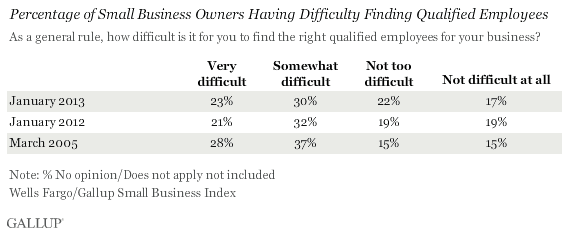
These results are from the quarterly Wells Fargo/Gallup Small Business survey, conducted Jan. 7-11, 2013, with a random sample of 601 small-business owners. Gallup asked these questions in two earlier Wells Fargo/Gallup Small Business surveys, in January 2012 and March 2005.
One in four owners (27%) say the difficulty in getting highly qualified employees to work for them has hurt their business over the past 12 months. This is up from 21% in January of last year, and is identical to the March 2005 reading.

Two in three U.S. small-business owners say word-of-mouth is a "major way" they find new employees, essentially the same as in 2012 and 2005. Employee referrals are the second-most-frequently mentioned method of finding employees, at 47%. Both of these are significantly higher than the 15% who say the Internet is a "major way," the 9% who say newspaper ads, and the 4% who mention recruiters. Small-business owners' use of the Internet as a major resource for hiring more than doubled between 2005 and 2012, while their use of newspapers did the reverse. Internet use for hiring fell back slightly to 15% in 2013, while newspaper use was unchanged. Throughout these changes, word of mouth has remained by far the preferred method.
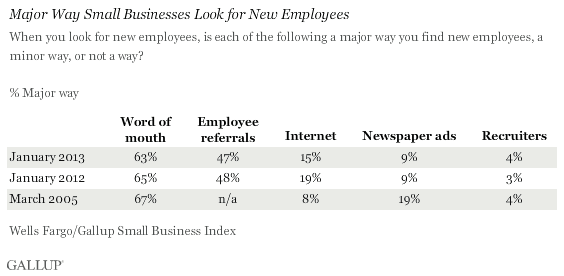
Increased Customer Demand and Growth Continue to Drive Hiring
Nationwide, 17% of small-business owners say they are looking to hire new employees. Of these, 70% are doing so due to increased demand for their products and services, 68% because of expanded business operations, and 64% because revenues are high enough to justify additional employees. Nearly half (47%) are hiring to replace an employee who left. Another 14% say getting additional capital for their business allowed them to hire and 10% indicated that government tax incentives allowed them to do so.
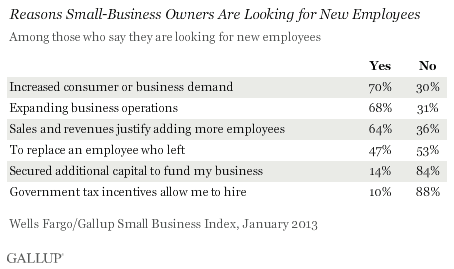
As has typically been the case, small-business owners are more likely to look for temporary or contract workers (40%) or part-time employees (36%) than full-time workers (22%) to meet their hiring needs. This is not much different from the January 2012 or January 2008 results.
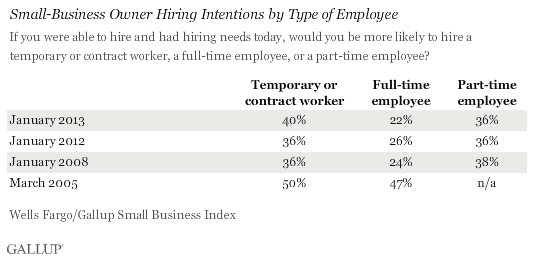
In January, 35% of owners reported hiring fewer workers than they needed, up from 29% a year ago, but lower than the 42% of November 2010. Fifty-six percent of small businesses hired as many employees as they needed, while 7% hired more workers than they needed immediately.
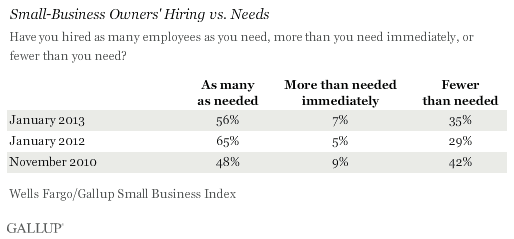
When small-business owners can't afford to hire the workers they need, they tend to seek unpaid help. When asked whom they turn to most for unpaid help, 28% said their spouse, 14% said their children, 13% a friend, 7% another relative, and 6% an intern. Thirty percent of owners said they do not use unpaid help.
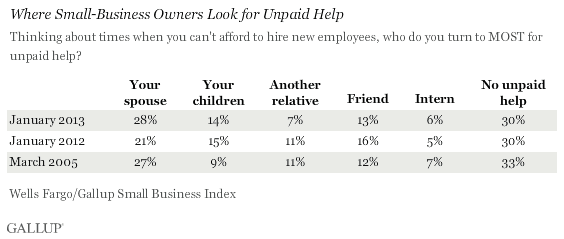
Implications
Although small-business owners are more positive about their operating environment than they were late last year, they remain far less optimistic than they were prior to the recession and financial crisis of 2008-2009. As a result, it is not surprising that owners continue to hire fewer new employees than they are letting go in early 2013.
However, today's weak job market -- and lack of small-business hiring -- makes it all the more worrying that 53% of owners report it is difficult to find the qualified employees they need, particularly when 27% of owners say this has hurt their business over the past 12 months.
In the immediate term, this lack of qualified employees may be holding back the U.S. economy on the margins. While the economy is growing slowly overall, there are some industries and areas of the country -- such as those at the center of the energy revolution -- that are expanding rapidly. A lack of qualified employees might be a significant problem in such instances.
More broadly, this lack of qualified employees likely reflects some of the nation's more serious longer-term structural problems. For example, the length of the current jobs recession has left many workers unemployed for long periods of time. In turn, this may mean that many workers no longer have the skills today's businesses need. Similarly, the lack of jobs across the economy has left many younger Americans without job experience -- something businesses also look for when seeking qualified employees. Of course, there is also the issue of whether today's education system is able to develop the highly qualified employees U.S. businesses need to compete in the global economy.
Regardless, 35% of today's small businesses say they are hiring fewer employees than they need. This implies that when the economy actually returns to its normal growth path, there could be an explosion in small-business hiring needs. In turn, the unavailability of highly qualified U.S. workers could go from being a major concern to a crisis -- holding back economic expansion and the growth of the U.S. workforce.
About the Wells-Fargo Small Business Index
Since August 2003, the Wells Fargo/Gallup Small Business Index has surveyed small-business owners on current and future perceptions of their business financial situations.
Survey Methods
Results for the total dataset are based on telephone interviews with 601 small-business owners, conducted Jan. 7-11, 2013. For results based on the total sample of small-business owners, one can say with 95% confidence that the margin of sampling error is ±4 percentage points.
Sampling is done on a random-digit-dial basis using Dun & Bradstreet sampling of small businesses having $20 million or less of sales or revenues. The data are weighted to be representative of U.S. small businesses within this size range nationwide.
In addition to sampling error, question wording and practical difficulties in conducting surveys can introduce error or bias into the findings of public opinion polls.
For more details on Gallup's polling methodology, visit www.gallup.com.
